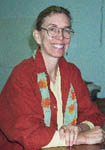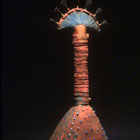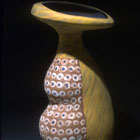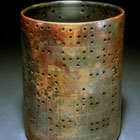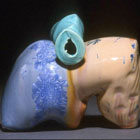INGRID LILLIGREN
artwork | audio | statement | galleries
artwork
audio 
- First memory (61 sec. | 419KB): listen | read
- Media (59 sec. | 402KB): listen | read
- Sensory realm (55 sec. | 379KB): listen | read
- Teaching (41 sec. | 282KB): listen | read
- Critique (48 sec. | 331KB): listen | read
- Advice (55 sec. | 380KB): listen | read
artist statement
Dee's Sniffer, 2002
An homage to my friend, the artist Dee Marcellus Cole. She is exactly as tall as this piece and her nose comes to the opening in the front. A small pouch with herbs hangs inside. Scent is a strong prompt to memory and is a component I have used in a number of pieces. Her work is playful and incorporated mixed media; she often makes use of children's cowboy boots for the feet on her pieces. Her personality is strong and feminine; she buys many of her clothes at thrift stores and usually wears a skirt. During a recent taping for a TV show, she was asked to drape one of her figures as the generalized forms that represented breasts were deemed potentially inflammatory to viewers, so I had to include breasts in this piece.
Yearning, 2002
First constructed in 1995, this piece encountered the uneven concrete of the back patio resulting in its early demise. In the course of rebuilding, the piece has evolved. The circles painted onto the triple belly represent a continuous cycle of counting days, an activity familiar to women as they keep track of their menstrual periods. I added the ear to the bowl area—one of the meanings of 'yearn' is to utter in an emotional voice and I wanted those utterances to have some chance of being heard. The piece is intended to express deep longing and yet contain a measure of hopefulness.
Foreign Aid, Part A, 2003 (text for Braille on cylinder, one of six)
(Part A): Gwen Ifill recently interviewed the Carters on PBS. Jimmy Carter made the remark that for every dollar of (Part B): Foreign Aid the U. S. donated, Norway was giving seventeen.
I decided to investigate. (#3): What I found was illuminating. The U.S. is dead last of 22 industrialized nations in foreign aid donations relative to gross domestic product. What a shame. The internet has thousands of sites with statistics, most of them quite alarming. (#4): I once read a definition of beauty as a purely aesthetic response, a disinterested observation, objective and objectifying. Statistics too put us at a remove. How can we put a face on the numbers we read about daily? (#5): How much cultural and personal identity have we invested in the remove that disinterested beauty and compressed data provides? (#6): If we define beauty to include engagement, could or would our relationship to the world and its issues change?
Dilly Dally, 2005
Crystalline glazes have a mystique about them—they are difficult to produce and erratic in nature. When they do work, they are gaudy, spectacular and mysterious. Each zinc based glaze has unique minerals that produce the colors and to an extent, the textures characteristic of these glazes.
In the back of my mind I have been thinking of working with crystalline glazes for several years as I thought these glazes might be well suited to the organic, biomorphic forms I make. They appeared to call out for a decorative finish, something elaborate and juicy. The current pieces use both crystalline and regular high temperature glazes. As the crystals appear randomly on the surface of the form, I think of them as recalcitrant manifestations of joyous play, neither here nor there, occurring in unexpected locations. Being whimsical in nature, they are named appropriately. Dilly dally means to waste time in hesitation or vacillation, to loiter or dawdle.
audio text
First memory
Probably the very first memory I have is being in a closet. I have the door partway open. It's dark, but there's a little bit of light coming in through the door. My father had a tie rack that was circular. It had spokes coming out of it with little turned up ends, and you hung ties on the spokes. And if you took all the ties off, this spun; and in the light, it twinkled. So it's both a visual memory of particular lighting, the quality of being safe and protected in a soft environment, but also this curiosity about the mechanics of how something worked. I think those two interests have stayed with me just real steadily ever since.
I was always doing something that I guess you would call art. All of us grew up knowing how to sew. My father is very handy; he always had a shop. Each one of us had a work space along a bench. So I remember growing up manipulating objects with my hands and using tools, always having a tool sense.
Media
I think if I were going to say something, I would say I'm a sculptor, I work primarily with clay. My work is an investigation of ideas that I have, and because I have worked in a number of media, I can express those ideas a number of different ways. I guess probably the best way to describe my work is that there are periods of time when I have expanded beyond the studio production and done more public larger installation kinds of things. But I really would not say that I am just an installation artist or just a studio artist. There's some mix between that really follows very closely what it is I feel I need to do to make the work. I think to a certain extent it would be easier to present myself, to make clear who and what I am, if I did maybe only three or four of what I do, as opposed to the great number of things. But that's just not who I am, and so I pursue what I pursue.
Sensory realm
I think that all of the work deals on some level in a sort of a nascent way with an autobiographical origin—something that is going on between myself and somebody else or others is what gets it started. And I think that that is probably the thread that runs through all of the work, is the connection to people. I think the experience that I'm most interested in viewers having is one of relating to the work in a fairly physical way, of having a visceral response, as well as thinking about it, as well as being made curious. The sensual realm—sensory realm—is very powerful, and very much an area that I consciously work to activate. It's a way to celebrate being human and it's a way to connect us to our bodies that I find compelling and very important.
Teaching
I am extroverted; I am a people person. I like those connections, so that feeds me as a person, and that eventually feeds my work. I have to problem solve all the time when I'm teaching, I have to explain things, and it helps me when I go back to my own work. I love to tell the students that I'm really only about two weeks ahead of them. But I'm always going to be two weeks ahead of them. And that's sort of the way that it feels. In some ways I know more than they do, but boy, I'm always surprised and humbled by the creative process. And it's such an honor to be present at that moment when students start to understand things, and to watch them have their brains stimulated by discovery and connections.
Critique
I genuinely solicit critique from colleagues and I guess that I would make the distinction between critique and criticism. Critique is that which I seek out and look for as constructive. Like my students, I think I do the best job of criticizing my work. But I think that it's an important part of learning, both to distinguish between what is valuable in critique or criticism, and being able to take that and use it and grow in a healthy way. There's also a lot of criticism that's just a matter of somebody's opinion that is not necessarily something you have to agree with. It's just really important to always remember that whatever anybody has made, it's really rare for somebody to make something sarcastically. I mean, they may have sarcasm as their intent, but people are close to what they make. It lives in them and it comes out.
Advice
The first thing would be to ask her, what is her highest vision for herself, for her work? And the second thing, what is your next step to achieving this? And the third, where are you going to get stuck? Where will you set a limit for yourself or where will there be a limit set for you? And the fourth, how will you go beyond this? What are your resources; who can help you? Who do you turn to when you get stuck? And the fifth thing that I would say to her is, don't have anybody in your life that's really close to you, that isn't a hundred percent for you, because it's hard enough being an artist. It's very important to take your education seriously, and to take the work of being an artist seriously, without being heavy-handed about it. I mean, you need to be able to balance it. So, mostly what I try to encourage them to do is to know how to dream and be the best thinker and problem solver, get the best support that they can get for themselves, and to take themselves seriously.

